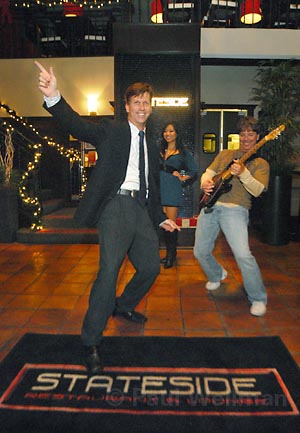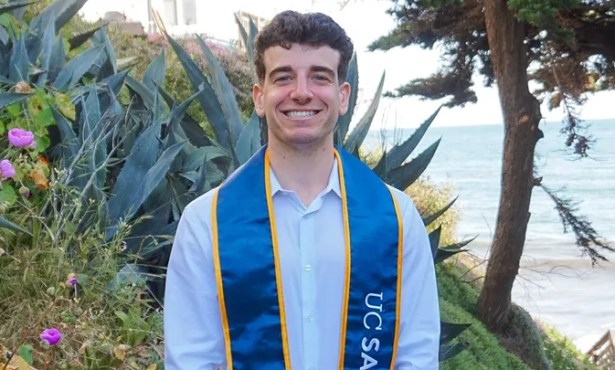The Dance Permit Shuffle
Stateside Snags One, But Will Others Boogie Down So Easily?

The patrons of Stateside Restaurant & Lounge are ready get down after the recent approval of a dance permit by the Santa Barbara Fire and Police Commission.
The process of acquiring a permit took about four months and forced Stateside to instigate a “no dancing” policy in October when it first opened in La Arcada Court. It is also a financially costly undertaking, with each permit going for around $1,200. Furthermore, in Stateside’s case, the cost of obtaining a dance permit also included paying for legal advice throughout the process, according to Stateside manager Warren Butler.
Despite the time and monetary commitment involved, Butler said that overall the process went smoothly. “We were very proactive about finding out what the process and requirements were,” he recalled. They made sure that they met all security requirements, including installing cameras and hiring the necessary number of security personnel, agreed to refrain from playing music on their patio area after 10 p.m., and filled out all of the paperwork required by the commission. Butler explained that he saw a jump in business when the club’s permit was approved last month. “We always envisioned a higher-end place for people to lounge around and dance,” he said. “People love to dance in S.B., so if you don’t have dancing, it’s difficult to create a nice lounge atmosphere.”
Allowing dancing without a dance permit was never considered an option for Stateside or other local bars. In addition to showing a blatant disrespect for the law and alienating the various governmental agencies involved in obtaining a permit-the City Council, Police and Fire Commission, and police officers-unpermitted dancing can cause clubs to be given fines of around $75 per offense, explained S.B. police spokesman Lt. Paul McCaffrey.
Stateside’s recent permit acquisition may have narrowly escaped being swept up in an ongoing debate over the city’s dance permit policy. The city ordinance committee began working to update the relevant municipal code in December 2005. A formal proposal is being prepared for an upcoming City Council meeting, which may include previously discussed changes such as capping the number of dance permits on lower State Street at the current 14 and issuing a maximum of 25 in the city, requiring annual renewal of the permits, including premise inspections, and requiring criminal background checks of club owners.
These precautions may seem unnecessary for a permit that allows for nothing more than your average dancer’s spinning and shaking. That’s because, in reality, the dance permit restrictions have nothing to do with the subtle dangers of the merengue. Instead, policymakers and community members alike are using the permit to regulate other aspects of nightclub practices. In the current process, the city already uses the permit as an incentive to make sure that nightclubs have adequate security and to encourage the responsible business practices of their owners. In fact, the permit is the only aspect of a nightclub over which the city has direct influence.
As with the granting and attempted repeal of the Sandbar’s permit last spring, there are two sides to the dance permit debate, both with vocal proponents. In the Sandbar instance, the new owners had successfully met the Fire and Police Commission’s requirements and was approved for a dance permit, but representatives from local businesses, including the Hotel Santa Barbara and the Holiday Inn Express, attended the meeting and tried unsuccessfully to overturn the decision, citing noise pollution as their main objection.
“We have a specific spot in the hotel that is very close to Madison’s, and sometimes we do get complaints [about the noise],” said Jason Mehrens, longtime front desk agent for Hotel Santa Barbara. The hotel’s concerns about its guests’ comfort may be legitimate, but will the issuing of a dance permit increase a bar’s volume level? Mehrens doesn’t seem to think so. “It’s pretty loud anyway. I don’t know if a dance permit would really change things,” he said.
McCaffrey explained the Police Department’s stance on the regulation of dance permits. “Our bottom line is we want it to be safe,” he said. “When the police department weighs in on any kind of [dance permit] issue, one thing that we do is we look at calls for service. How much crime happens on [the lower] part of State Street? The answer is a lot.” McCaffrey went on to list violence, sexual assault, and drunk driving as some of the crimes police have to deal with on downtown State Street. These safety concerns help explain why the proposed changes to the city’s dance permit law may include harsher restrictions for the entertainment district-the area bordered by Chapala, Santa Barbara, Ortega, and Gutierrez streets.
One may note, however, that the safety concerns McCaffrey referred to did not include any crimes directly related to dancing. How, then, can restricting dancing control downtown crime rates? “Dancing doesn’t cause violence,” agrees McCaffrey, but “the dancing does bring more people into a club. People drink more when there is a dance permit. The businesses : will get more customers who will buy more alcohol.” By increasing the amount of drunk people on the street, he said, dance permits can indirectly influence crime rates.
One local bar owner had a different view on the subject. “I think that telling people not to dance is ridiculous,” said the owner, who requested to remain anonymous. He never applied for a permit. “I’m glad that I don’t have one. : There’s less bureaucracy forced upon me because I don’t have one.” He mentioned hassles such as asking neighboring businesses if they object, performing building modifications that must go through the Planning Commission, and earlier last calls. This “bureaucracy” could intensify with the new restrictions discussed for January’s proposal.
Stateside’s manager Butler said that he understands where police and policymakers are coming from in requiring dance permits. “They want to make sure people are responsible in turning their liquor license into a nightclub. : It’s a beautiful town and you know they want to keep it that way. I don’t think it’s a bad thing,” he said. However, Butler also suggested that limiting nightclubs with dancing to a certain set number would be a step too far, saying, “I wouldn’t want to limit it. It would keep out new businesses. It would keep out better businesses.”
At least Butler and the owners of the new Stateside Restaurant and Lounge can rest easy knowing that they escaped the potential difficulties faced by business owners looking to expand into the dance arena in the new year. Everyone else concerned will have an opportunity to speak their minds at the City Council meeting on January 15, at which a full report and a proposal for a new Dance Permit Ordinance will be presented. Until then, twisting and shouting in local clubs will likely continue through the holidays-to the delight of patrons and club owners and to the chagrin of those who would rather appreciate a silent night.



